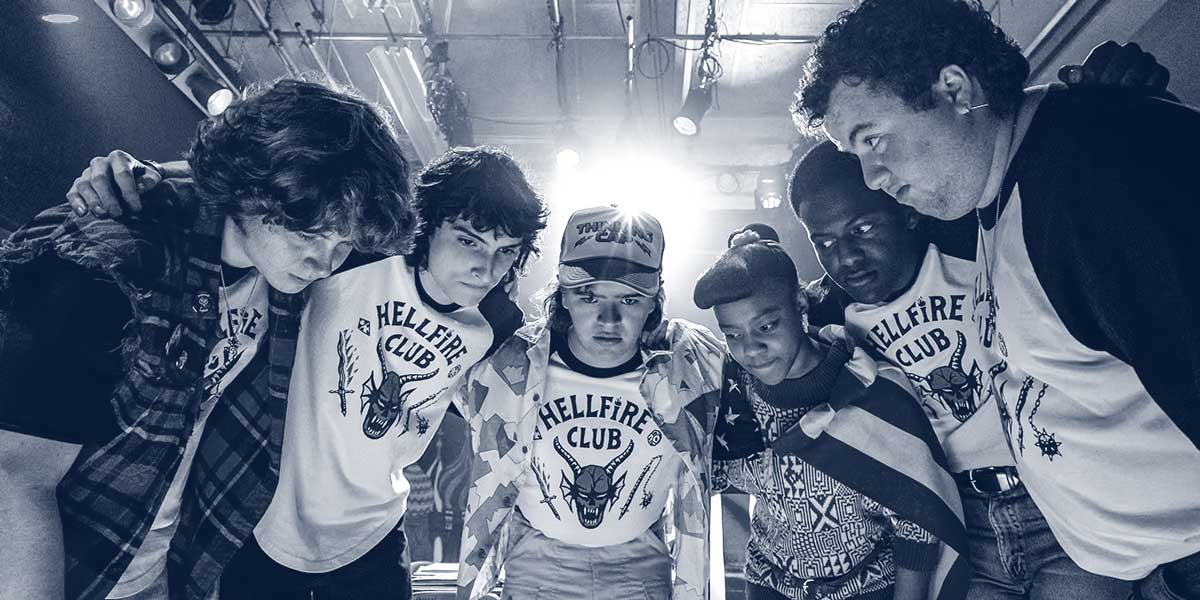Dungeons & Dragons Player’s Handbook
The original role-playing game and pioneer of collaborative worldbuilding

Hellfire Club
Dungeons and Dragons (D&D) pioneered the concept of a collaborative multiverse – storyworlds connected to each other by the lore and the structure of the game, but each with their own unique elements, characters, and challenges.
The authors’ claim that modern video and tabletop games owe a debt to D&D could be supplemented with the observation that much of 21st-century science-fiction storytelling and crossovers into technology owes a similar debt. Online worlds such as Minecraft, Second Life or a more contemporary metaverse, all exist within the same collaborative and creative spectrum as D&D. In the narrative and theatrical realm, stories that employ a device of multiple worlds are now so common as to verge on cliché, though Everything Everywhere All at Once is a standout example.
In some cases, such as Stranger Things, Dungeons & Dragons is referenced directly and used to set the scene for an analogous storyline.

Adventure calls
Dungeons and Dragons is a tabletop role-playing game dating back to 1974. The core activity of players is The Adventure, established by the Dungeon Master (game leader), and played out by characters with specific physical, personality and magical traits; in innumerable worlds and against a wide selection of adversaries of varying species and capabilities.
Though we are dealing here with a game, the structure of adventures strongly resembles that of a fantasy narrative, with a beginning, middle and end, though the timing of this sequence varies from game to game.
What we have, in this collaborative gameplay, is a Hero’s Journey, emergent through the interaction of the Dungeon Master, the players and the setting.
The authors identify three pillars of adventure: exploration, social interaction and combat. Together, the need for structure in employing these devices drives the creation of the content that has found its way into this handbook.
Practically, the handbook is divided into three main parts:
- Creating a Character, which goes into great detail on the player’s options
- Playing the Game, which goes into the process
- and The Rules of Magic, a critical component providing players with the pixie dust to sprinkle over their gameplay
Ultimately, the handbook serves well as a reference text for beginners and the experienced alike, however the best education on the game comes through play itself.
Worldbuilding
With the variety of characteristic definitions of people, places and cultures, we are solidly within the realm of worldbuilding - the craft of context-setting within which stories are told and games are played. The influence of the oft-referenced worldbuilding of Tolkein’s Middle-earth is evident, with dwarfs, elves, gnomes, and the like. Unique physical and cultural characteristics are intertwined with supernatural abilities and lifespans.
The most recognisable race in the game is of course the human race. In D&D, human beings are bestowed the greatest degree of variety and nuance, presumably because we, the readers and players, must maintain our suspension of disbelief in personas that resemble ourselves. If humans had been reduced to simplistic characteristics such as ‘X’ height, ‘Y’ language and ‘Z’ personality, the generalisations might break the spell.
Not so with elves and dwarfs, though, who are effectively ‘othered’. It is perhaps a minor point given all the other complexities that must be taken on board, but the warning stands, nevertheless, not to be simplistic in the craft of worldbuilding.
Gamechanging
In his preface, Mike Mearls gives us a piece of advice. Detailed handbook notwithstanding, we do not need to “read all the rules, memorise every detail of the game, or master the fine art of rolling funny looking dice”. The foundations of the game are rather friendship and collaborative creation. He suggests that even if you do not begin a game as friends, you will likely end it that way.
Critically, the example that you take away from Dungeons & Dragons is that under the right circumstances, we have the ability to improvise, create and share, “rather than simply accept what is”.
Collaborative creation
Gameplay in Dungeons & Dragons is an act of collaborative worldbuilding.
Beyond the framework of the core game elements, usefully laid out in this handbook, and the point of departure established by the Dungeon Master, players effectively make it up as they go along … together.
As a tabletop game, without the visual feedback of a screen-based video game, much of this worldbuilding takes place within the imagination of the players themselves. This is a fundamentally different mental and creative exercise than we might encounter when playing say Fortnite or football.
Beyond the suspension of disbelief that we experience in the context of narrative storytelling, the phenomenon here is more akin to the shared production of disbelief that emerges within the play of alternate reality games.
As we will see with our next review on matrix wargaming, this role-playing game, conceived for entertainment, has the potential to set the example of a powerful conceptual and educational tool.
Authors: Jeremy Crawford, James Wyatt, Robert J. Schwalb, Bruce R. Cordell
Year of Publication: 2014
